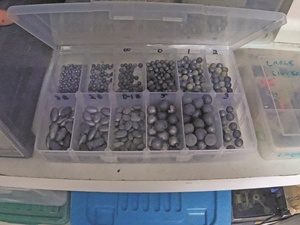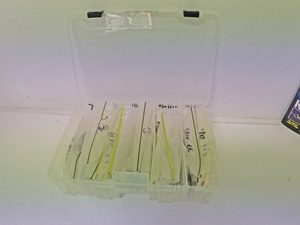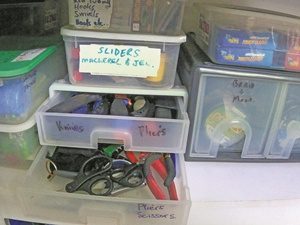






IN recent months we have been faced with strong winds, big seas and even COVID-19 lockdowns limiting fishing options. So what can you do? Sort out your fishing tackle, of course!
In this article I outline a number of fishing tackle storage and preparation strategies I use so I’m well placed to find the gear I want in a hurry. By organising your gear by species, colour or water depth specific tackle or storage boxes you will be much better placed to hit the water in a hurry. Similarly on the water you will catch more fish by having everything organised and not in a jumbled mess. Tackle storage
Rods and reels
One of the best yet simple bits of fishing organisation I’ve done in recent years is with pen and paper. That is, I bought a little notebook and wrote down all my reel types and what brand and size line and leader I had on them, and if I knew it the age of the line. In fact, I even went to my local stationery store and bought an erasable pen. This way when I replace line on a reel, I can simply erase what was there before.Tackle storage
I do this regularly when I swap leader. It can be so hard and a bit of a lucky dip to remember what leader you put on what reel at times. This does away with that guesswork. When it comes to the age of the line, for reels I use regularly or where the line is getting low on the reel, I will make a decision on whether to just top it up or if it is a year or two old, replace it altogether.
Even if you don’t do this, at the very least look after your line and never store your reels in direct sunlight. Another tip is to trim the first metre or two of line after big sessions, particularly around rugged structure, as wear and tear on the line will weaken it. When it comes to rods, I like to store my rods vertically, with the reels removed in vertical rod racks.Tackle storage
This avoids leaning rods against a wall under pressure, potentially resulting in bent tips, particularly if they are rigged up. After giving my reels a gentle spray and drying them off after a saltwater session, I will back off the drags before storing them.
Line storage
For storage of my spare line, braid and leader, I like to place them in line strength order in a set of twin drawers from Bunnings. In fact, I have a few of these stackable drawers from Bunnings in the ‘All Set’ brand. They have horizontal twin drawers – which are a good size and shape to fit spools of line – vertical twin drawers and single drawer units.Tackle storage
All are less than $10 each and a great storage option. When considering fluorocarbon leader, I love the Stealth range from Platypus for both their quality and strength for such a thin diameter line, but also the fact they come with a line tamer. This stops loose spools of line coming off in your storage containersTackle storage
Terminal tackle
While many people are fans of the big portable tackle boxes, I’ve never been a fan, particularly those hinged-drawer types that pull out. One false move and the lot is a mess on the ground and in the box. Apart from that, they are big and bulky to carry. Instead I like to use smaller portable tackle boxes. The smallest ones are great to carry a few sinkers, hooks, swivels, beads and such for a session on the beach or sand flats.
For the bigger tray boxes with around 18-24 dividers, I like to use these in my boat to cover a variety of options, and hook and sinker ranges. I separate the sinkers and hooks and mark their size with a marker pen in their individual cube. For example, I carry one tray for lighter-line species such as whiting and one for bigger, and another for heavier-gear species similar to snapper and reef fish.Tackle storage
I also keep a ‘mothership’ or two of sinkers at home in my cupboard, which I will draw from to top-up these trays and boxes from time to time. Sorting them into size will avoid the situation where you are searching through a mess of different sized sinkers thrown together and not knowing what is what. For spare packets of hooks, swivels, beads and red tubing, I also have a separate container to store them all neatly and to access easily.
Lures and rigs
Additionally, when it comes to my pre-made rigs, I like to have them sorted neatly and organised. As an example, I keep a mix of winter, summer and deep-water whiting rigs wrapped around pieces of pool noodles cut in half for a smaller diameter in Tupperware containers, together with matching small tackle boxes. This way I can grab them and go when the wind and tide are right.Tackle storage
The same goes for my tailor rigs. I make up tailor rigs and wrap aluminium foil around the ganged hooks and coil the line and sinker inside small snap-lock sandwich bags. These are then sorted by sinker size in a few very convenient and organised Black Magic Deep Utility boxes. For my hard-bodies, I like to sort them in tackle trays according to depth at which they dive.
I sort them into shallow, medium and deep diving trays. This way if I’m trolling shallow water for flathead, I have a mix of colours and brands to choose from within the one tray. Of course, I will carry a couple of thin trays for different depths and all neatly stored together in a bigger storage container with spare trebles, split rings, pliers, spare leader and more.Tackle storage
For my tailor lures, I have a few mothership trays to take on trips, but then smaller waterproof boxes with a mix of colours and types – poppers, metals and bibless lures – to carry in my shoulder bag when spinning the beach. When it comes to soft plastics, I like to sort them in boxes according to colour. This way when I’m on the boat and need a colour change to match the water, I can find what I need quickly and easily and get my lure back in the water.
Accessories
When it comes time to make rigs, it can be frustrating to search around looking for split ring pliers, braid scissors, knives and such – again I like to have them neatly stored in the stackable drawers I mentioned earlier. I mark each drawer with a marker pen too in terms of what is inside. Waders and wet weather gear are also stored in their own storage crates and near the rest of my gear, so when I’m packing for a trip I don’t forget them.Tackle storage
Last but not least, I keep my beach-fishing accessories like shoulder bags, bait boxes and belts, rulers, dry packs, worming bags and more in the one big storage crate – it’s all in the one place and ready to grab for a trip. So there you go, I hope my storage and tackle organisation tips help you.Tackle storage
Remember the more organised you are off the water, the more organised you will be on the water and as a result you will spend less time with your line out of the water when the fish are on. For more tips, tricks and reports jump on and like my Facebook and Instagram pages.
To watch a video from the author detailing tackle storage, click here.
 Bush 'n Beach Fishing Magazine Location reports & tips for fishing, boating, camping, kayaking, 4WDing in Queensland and Northern NSW
Bush 'n Beach Fishing Magazine Location reports & tips for fishing, boating, camping, kayaking, 4WDing in Queensland and Northern NSW








